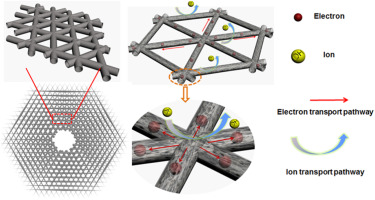Nano Energy ( IF 17.6 ) Pub Date : 2018-01-16 , DOI: 10.1016/j.nanoen.2018.01.024 Juan Wu , Xiling Shi , Weijie Song , Hua Ren , Changbin Tan , Shaochun Tang , Xiangkang Meng

|
We report a significant advance in the design and fabrication of MCo2S4 (M = Ni, Fe, Zn) complex hierarchical structures with well-defined morphologies by achieving novel hierarchically porous hexagonal microsheets constructed by well-interwoven nanotube networks using a controllable two-step anion-exchange technique. Uniform and smooth hexagonal sheets are initially achieved for the first anion-exchange leading to nanowire-woven hexagons, followed by transformation of each nanowire to rough MCo2S4 nanotube via the second anion-exchange. The involved mechanism of this general top-down method allowing fine nanostructure control is clarified based on our proposed new insights into ion-induced anisotropic growth and time-dependent anion-exchange reaction kinetics. The merits of both maximized porosity and low resistance facilitate fast electron transfer/ion diffusion, thus NiCo2S4 electrode material exhibits a higher specific capacitance of 1780 F g−1 and superior rate capability than most reported NiCo2S4 nanostructures with different morphologies as well as excellent stability (92.4% capacity retention after 10,000 cycles at 10 A g−1). Furthermore, an asymmetric solid-state supercapacitor using such NiCo2S4 as positive and N-doped graphene film as negative electrodes achieves outstanding cycle ability (92.1% retention over 5000 cycles at 20 A g−1) and higher energy density of 67.2 W h kg−1 (at 900 W kg−1) than that of similar devices. Such MCo2S4 electrode materials are promising for the future generation of high performance supercapacitors.
中文翻译:

通过两步阴离子交换,由交织良好的MCo 2 S 4(M = Ni,Fe,Zn)纳米管网络构成的多层多孔六边形微片,用于高性能不对称超级电容器
我们报告了通过设计和制造MCo 2 S 4(M = Ni,Fe,Zn)具有复杂定义形态的复杂分层结构的重大进展,该结构通过使用可控的两个很好地交织的纳米管网络实现了新颖的分层多孔六角形微片步阴离子交换技术。最初通过阴离子交换生成纳米线编织的六边形,首先获得均匀且光滑的六边形薄片,然后将每根纳米线转换为粗糙的MCo 2 S 4。通过第二个阴离子交换的碳纳米管。基于我们提出的对离子诱导的各向异性生长和随时间变化的阴离子交换反应动力学的新见解,阐明了这种一般的自上而下方法允许精细纳米结构控制的机理。与大多数报道的具有不同形态的NiCo 2 S 4纳米结构相比,最大化孔隙率和低电阻的优点有利于快速的电子转移/离子扩散,因此NiCo 2 S 4电极材料具有更高的比电容1780 F g -1和优异的倍率性能。以及出色的稳定性(在10 A g -1的10,000次循环后,容量保持率为92.4%)。此外,使用此类NiCo 2 S 4作为正电极和N掺杂石墨烯膜作为负电极的非对称固态超级电容器可实现出色的循环能力(在20 A g -1的5000次循环中保持92.1%的保留率)和67.2 W的更高能量密度h kg -1(在900 W kg -1时),比类似设备的h kg -1。这种MCo 2 S 4电极材料有望用于下一代高性能超级电容器。


























 京公网安备 11010802027423号
京公网安备 11010802027423号